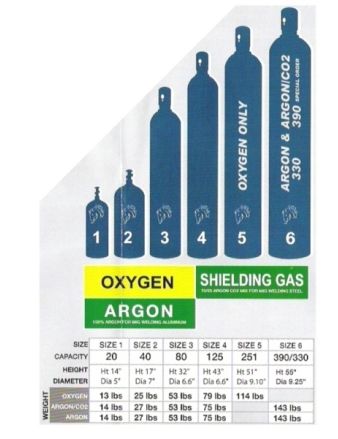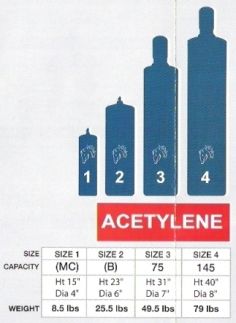

The business of buying "used" tanks is a true snake pit. Many tanks are in truth leased, which means that they are owned by the company leasing them and cannot be sold to someone else. If you did buy such tanks (which typically are marked by the companies name stamped into the metal) and try to get them filled, they quite likely would be confiscated.
Beware of rules about getting bottles refilled, which vary from state to state and from company to company.
If the bottles have no such marks, they are your property and in Arizona at least, any company will fill them (in truth they will swap them for a full bottle). In theory you are responsible to keep them in hydro and fix problems with the valves, but since you are exchanging them, this is not an issue, unless you don't use it for a long time and it requires a hydro inspection. This will cost you an extra $25 or so.
Here are some more details about figuring out whether you want to buy a used set of bottles. Carefully inspect the neck ring and the area on the bottle near the neck. If they are marked "property of acme welding supply", do not buy them. If it is a company you have never heard of, just call your local welding supply place and ask them. For example, "Union Carbide" is found on some tanks, but they are no longer in the welding gas business and such a tank could be owned by an individual.
Also look at the ICC number. A bottle will typically have a marking like:
DOT 3AA 2265The number 2265 indicates that the tank is rated for 2265 PSI, i.e. it is a pressure rating, but it turns out that the shops in my area use this as a guide to identify leased tanks. Apparently most 2265 and 2400 psi rated large tanks are leased tanks (but not all). These will typically also have ownership markings.
The other issue with bottles is the "hydro test". Bottles must be tested and certified every 5 or 10 years and are stamped with the month and year of each test. If the digits for the year are followed by a star (or a box), the test is good for 10 years; if not, it is good for 5 years, so:


Rumor has it that the B size acetylene tank gets the "B" for bus, and the MC size acetylene tanks gets the "MC" for motorcycle (some say "motor car"), and this dates back to when they used the gas for headlights. The following data also applies, but I have had only limited success reconciling it with the above graphics. Apparently MC holds 10CF and B holds 40CF.
R - 20 CF - 5.3125" O.D. - 19" tall AXL - 55 CF - 41 tall Q - 80 CF- 7.125" O.D. - 35" tall XL - 70 CF - 6" O.D. - 41" tall D - 122 CF - 7.5" O.D. - 48" tall E or Y - 122 CF - 7.0" O.D. - 48" tall S - 150 CF - 7.375" O.D.- 51" tall LK - 244 CF- 8.9375" O.D. - 56" tall K or KL - 244 CF - 9.00" O.D. - 56" tall T - 330 CF - 9.25" O.D. - 60" tall
MC - 10 CF - 4" O.D. - 14" tall B - 40 CF - 6.25" O.D. - 23" tall WQ - 60 CF - 7.625" O.D. - 24.25" tall WC - 111 CF - 8.5" O.D. - 37.5" tall WS - 130 CF - 8.5" O.D. - 35.5" tall WSL - 130 CF - 8.5" O.D. - 33.5" tall WK - 304 CF - 12-.875" O.D. - 42" tall WTL - 390 CF - 12.5" O.D. - 44.375" tall
Never use the bottle with it on its side, as this may force acetone into the hoses and torch. Also, never allow acetylene pressures above 15 psi. Gaseous acetylene at pressures over 15 psi will begin to dissasociate, yielding heat and possible explosion. Having a fire extinguisher handy is a fine idea.
Acetylene tanks have fusible plugs designed to melt and release pressure at temperatures over 212 F.
Also if you draw acetylene at too fast a rate, the bottle can overheat and explode. The first rule of thumb I heard for this was 1/7 of the bottle capacity per hour. Obviously this is a big issue with small bottles. More recently I heard the recommendation of limiting the withdrawal rate to 1/10 of the cylinder capacity per hour in intermittent use and 1/15 of the cylinder capacity per hour in continuous use.
With the tiny "MC" bottle (10 CF capacity) that I used to have, drawing over 1 CF per hour would be hazardous (i.e. any use that drains the bottle in less than 10 hours would be inadvisable). What this means is that any use other than a few minutes here and there would not be a good idea. Here are some other related facts, with the bottle recommendations based on the 1/7 rule:
I have a little portable brazing/welding rig. As near as I can tell it has an MC size (10CF) acetylene bottle (8.5 pounds) along with a 20CF oxygen bottle (13 pounds). A good match given that you typically use oxygen at twice the rate as acetylene. And the pair of botles weighs 21.5 pounds, very portable.
To upgrade my 10CF acetylene bottle to a 40CF (size B) acetylene bottle would cost me $56.39 (in early 2010), but I might find that the valve thread size changes and I would then need an adapter. This bottle weighs 25.5 pounds.
To upgrade my 20CF oxygen bottle to a 55 CF size would cost me $87.20. The next size (80CF) would be more suitable (having twice the volume as the acetylene bottle it is paired with), but would also weigh 53 pounds instead of 25 pounds.
The size 40CF acetylene paired with the 55 CF oxygen would weigh 50.5 pounds.
Tom's Welding pages / tom@mmto.org